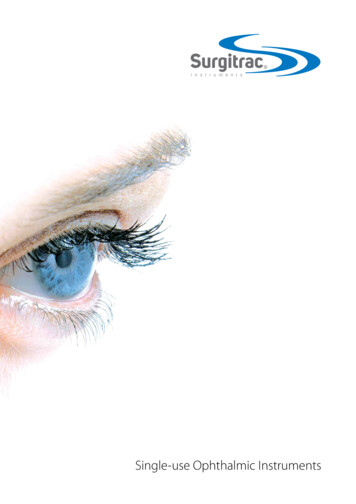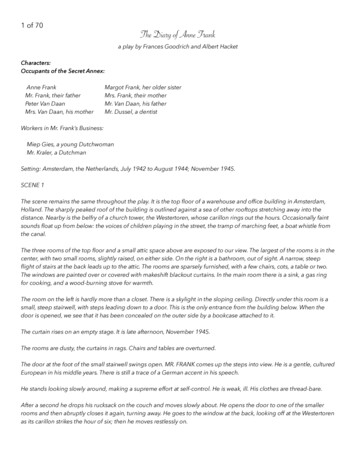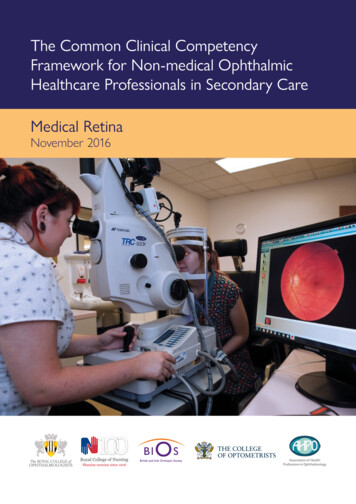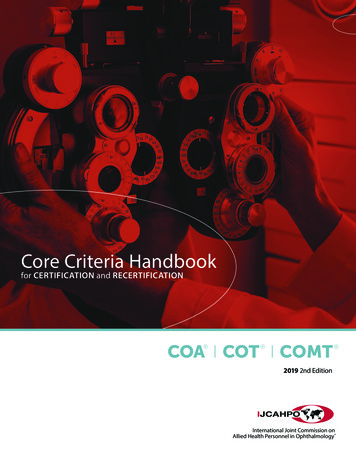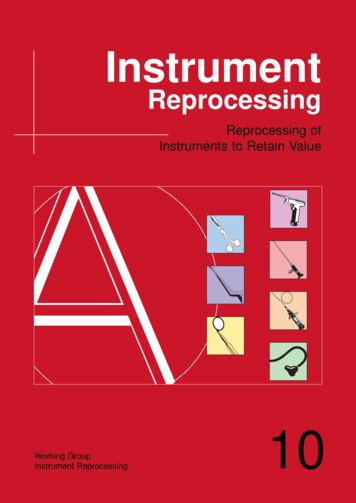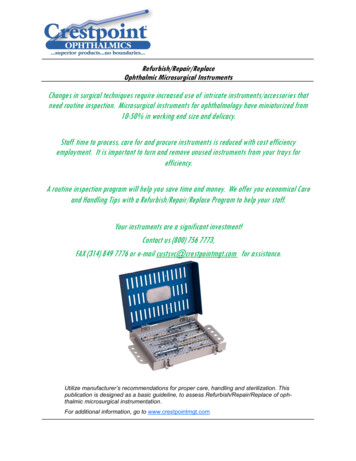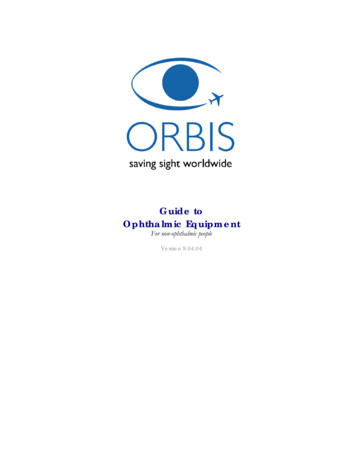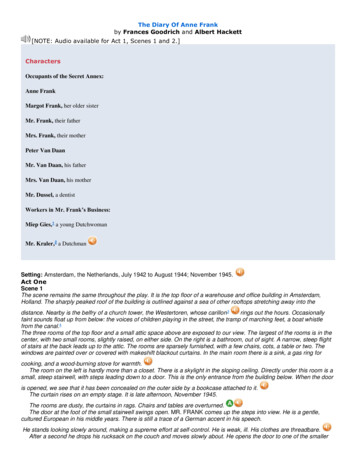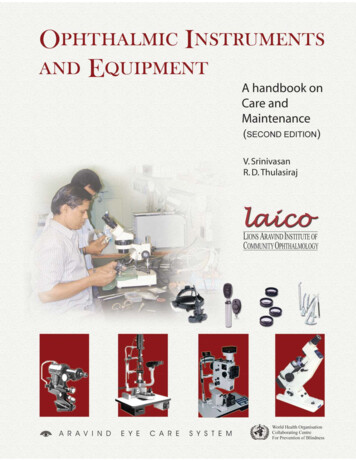
Transcription
Ophthalmic InstrumentsOphthalmicInstrtrumentsand Equipment- A handbook on care and maintenance(Second Edition)V. SrinivasanProfessor of PhysicsConsultant, Instruments Maintenance LaboratoryR.D. ThulasirajExecutive DirectorLions Aravind Institute of Community OphthalmologyA R A V I N DE Y EC A R ES Y S T E M
Edited and designed by :Aravind Publications staffPublished by :Aravind Eye Hospital& Postgraduate Institute of OphthalmologyMadurai, IndiaPrinted at :Sri Aurobindo Ashram Press36, Goubert Avenue, Pondicherry 605 002, IndiaFirst Edition, 1997Second Edition, 2003LIONS ARAVIND INSTITUTE OF COMMUNITY OPHTHALMOLOGY& Postgraduate Institute of Ophthalmology1, Anna Nagar, Madurai - 625 020, Tamil Nadu, IndiaPhone: 91-452-535 6100, Fax: 91-452-253 0984www.aravind.orgII
DedicationThis hand book is dedicated toPadmashri Dr. G. Venkataswamy andothers like him who have dedicated theirlives for the eradication of curableblindness.III
ContentsDEDICATIONIIIPREFACE TO THE SECOND EDITIONVIIPREFACE TO THE FIRST EDITIONIXINTRODUCTION1SECTION I1.2.3.GENERAL PRINCIPLES OF MAINTENANCE AND TERMINOLOGY3COMMON MAINTENANCE TASKS AND TECHNIQUES TO HANDLE THEM 6MAINTENANCE MANAGEMENT11SECTION II4.5.6.7.8.9.TORCH LIGHTOPHTHALMOSCOPERETINOSCOPEINDIRECT OPHTHALMOSCOPESLIT LAMPOTHER OPTICAL EQUIPMENT171924273137SECTION III10.11.GENERAL CARE OF SURGICAL INSTRUMENTSCARE OF KNIVES4042APPENDICESI.II.III.IV.MULTIMETEROPTICAL SURFACESSOME SIMPLE ELECTRICAL CALCULATIONSTRAINING COURSE4345464749INDEXV
Preface to the second editionTen thousand copies of the first edition were printed. A good number of them weredistributed to various users by the sponsors - DANPCB. The remaining copieswere sold out. There has been a persistent request to bring out a second edition. Therevision was getting postponed for want of good free time needed for such works.Based on our experience in running nearly thirty instruments maintenance courses inthe last seven years the book has been thoroughly revised and enlarged.This edition was also processed at the Aravind Communications Centre at LAICO.We record our appreciation for the patient work done by Mrs. Chitra Thulasiraj,Mrs. M. Jeyalakshmi and Mrs. Sharmila Noor.MaduraiSeptember 2003V. SrinivasanR.D. Thulasiraj VII
Preface to the First editionThe quality and efficiency of medical service provided in any hospital depends verymuch on the proper functioning of the equipment and instruments used by the doctors and other clinical staff. Even under normal and careful use, instruments fail tofunction properly. The frequency of such failures can be considerably reduced byproper care, maintenance and timely repair.Especially in ophthalmology, there has been a major increase in the use of sophisticated instruments and equipment during the last decade. This has led to a higherquality of eye care services, resulting in an increased demand for eye care servicesfrom the general public. But at the same time, this has created a higher dependencyupon the proper functioning of such equipment. It has therefore become imperativeto ensure that the necessary equipment is in an optimal condition. Hence this manual.This manual is intended for ophthalmic units delivering secondary level eye careservices. These units generally do not have special technical departments dealingwith maintenance and repair of medical equipment. It is written for clinical and technical staff, normally dealing with maintenance and care of equipment and does notrequire any special training in engineering.It is also intended for ophthalmologists and other clinical staff using these instrumentsand equipment. Not that ophthalmologists should become technicians, but as in healthcare, the rule “prevention is better and cheaper than cure” is also valid here. It isimportant that all junior staff is trained in the proper handling and care of each instrument, to know the optimal quality of its functioning and how to recognize any faults intime.Ophthalmologists and their patients will benefit most from equipment that functionswell and we do hope this manual will contribute to that.This is our first attempt to bring out such a handbook. Not all the instruments used byophthalmologists are included in it. In the instruments described, it is possible thatsome of the maintenance problems of users are not described. The users of thehandbook are requested to send all their comments and suggestions to us for improvement. All suggestions incorporated in subsequent editions of the handbook willbe suitably acknowledged.The publication of this handbook is sponsored by DANPCB (Danish Assistance tothe National Programme for Control of Blindness), New Delhi. We record our thanksto DANPCB and to Dr. Hans Limburg in particular for giving us this opportunity ofIX
putting together some of our ideas and experiences in maintenance of ophthalmicinstruments. We also thank Dr. Limburg for the editorial input.Dr. G. Venkataswamy, our Chairman, is a source of inspiration for everything thatgoes on at Aravind Eye Hospitals. The constant help and encouragement receivedfrom him is gratefully acknowledged.The book was processed in the Aravind Communications Centre of LAICO. Thework done by Mr. R. Saravanan and Mr. K. Lakshmanan deserves a special mention. We wish to record our appreciation of Mrs. Chitra Thulasiraj’s support in coordinating the DTP work and for the cover page design. The patient work ofMrs. J.Bharathy in putting together our manuscript initially deserves a special appreciation.MaduraiJune 1997V. SrinivasanR.D. ThulasirajX
IntroductionA maintenance manual for ophthalmic instruments and equipment has been a long felt need. Especially in thecontext of India and other developing countries that have poor service infrastructure, difficulties in communicationand in accessing required spares. This manual is an attempt to meet this need and to serve as a reference manual inthe field to assist the persons in-charge of maintenance.How to Use this Book: A manual is a reference guide to carry out repairs and maintenance. However, the widevariations between manufacturers and models make it impossible to provide specific step by step guide for each andevery equipment. Such an attempt will be quite futile given the rapid change of technology and introduction ofnew models. The detailed user level maintenance instructions for a specific equipment are usually provided in theowners manual supplied along with the equipment by the manufacturer. Thus the purpose of this manual is tosupplement the manuals supplied with the equipment.Some suppliers of equipments also supply service manuals on some guarantee that they would not bemisused. These manuals are intended for their service personnel and give elaborate step by step trouble shootingand repair procedures. An attempt should be made to get such manuals for one’s own use.Organization: This book is divided into three sections followed by appendices. The first section deals with generalprinciples of maintenance, maintenance procedures common to many instruments, minimum requirements forcarrying out maintenance function, record keeping and maintenance management. The second section deals withcare and maintenance of specific instruments and equipment. The third section deals with the maintenance ofsurgical instruments. The appendices give more information.The user of this manual is advised to go through and understand the first section completely as thatforms the basis for all maintenance activities. Some of the systems and procedures, that are suggested shouldbe put in place if not in practice already. The second and third section should be studied in an applied fashion.For instance, the chapter on slit lamp should be studied with a slit lamp physically present and the suggestedpreventive maintenance should be carried out as a practical session.STEPS THAT REQUIRE CAUTION, SPECIAL WARNINGS OR PRECAUTIONS ARE HIGHLIGHTED IN THIS COLOUR.Instrument or equipment? A dictionary defines instrument as a tool. Hospitals are equipped (furnished) with avariety of tools. Tools may also be referred to as equipments. A surgical knife is a tool, so also a surgical microscope.Tools help in carrying out a task accurately and with ease. However, in common parlance in hospitals, a distinctionis made between the two terms. Surgical knife, scissors, ophthalmoscope, etc. that are held in one's hand duringusage are referred to as instruments while surgical microscope, slit lamp, operating table, surgeon’s chair, etc. arereferred to as equipment. We will follow this distinction in this manual.Scope of the manual: The level of maintenance can vary from simple cleaning to sophisticated broad levels or evencomponent level repairs in electronic instruments. It may involve replacement of components of optical instruments. Similarly, the range of instruments can vary from a simple surgical knife to a complex laser system. Thismanual neither covers the entire range of equipments nor the more sophisticated maintenance activities. Thepurpose of this manual is to assist the person with the maintenance responsibilities to carry out simple maintenance1
INTRODUCTIONtasks on instruments and equipment that are commonly present in secondary eye care hospitals. The manual willenable one to carry out preventive maintenance, troubleshoot and identify problems and carry out customer levelmaintenance.Requisites of a maintenance person: Maintenance is a step by step process. Each person may evolve his own stepsand it is always good to go through all the steps on all occasion. Short circuiting of any step should be avoided.Only proper tools should be used for each job. One could take calculated risk in carrying out an unfamiliar job.One should not be scared of making a mistake. Only those who do no work make no mistakes. However oneshould learn from such mistakes. No mistake of a kind should happen more than once in the career of a maintenance person. It will always help to keep a record of all maintenance work including details of mistakes made andhow it was rectified. It is always good to teach others the various maintenance tasks. One would learn more whileteaching others. A good maintenance job is always satisfying.General: An instrument purchased from a well known manufacturer through a well known dealer will alwayswork well. Suppliers of instruments usually give a free warranty for periods ranging from a few months to a coupleof years. One should make good use of the instrument during the warranty period. Any failure due to faultycomponents or manufacturing defects will happen in the warranty time and efforts should be taken to rectify thesame. If an instrument has given good service during the warranty period one can expect an equally good service inthe following years.AN INSTRUMENT REPAIRED IS AN INSTRUMENT GAINED.Any instrument not in use but occupying much needed hospital space must be repaired and brought back toworking condition or should be withdrawn from the hospital and suitably disposed off.2
Section - ICHAPTER - 1General Principles of Maintenance & TerminologyMaintenance of equipment and instruments has to be an integral function of any activity that involves their use inany significant way. Maintenance management is a well evolved discipline and it is well recognized in the industry.However, in health care it is yet to gain the importance that it deserves. This is probably due to the history ofmedical practice where till recently there was very little dependence on instrumentation or equipment, either fordiagnosis or for treatment. X-ray machine and laboratory microscope were the most sophisticated equipment. Inthe last two decades, there has been a tremendous increase in the body of knowledge and newer technologies thatexploit this knowledge to provide better diagnosis and treatment.Instrumentation: Ophthalmology is one of the fields where there has been a tremendous innovation and technological growth. There was a time, not too long ago, when a patient with a cataract was diagnosed at best with thehelp of a torch light. He/She was then operated and no sutures were applied. The patient was bilaterally bandagedand had to stay immobile in bed for about a month. The outcome was often left to God. We are now back tosutureless surgery. But there is a big difference. The process of diagnosis has gone beyond determining just thepresence of lens opacities. A keratometer is used to measure the curvature of the cornea and the astigmatism. Basedon this, the surgical strategy is planned on the site of the incision to reduce the astigmatism. An ultrasound scanner(A-Scan) is used to determine the length of the eye ball. This information, together with the keratometry values andthe patient’s visual needs are used to compute the power of the intraocular lens (IOL) to be implanted. An interferometer is available to predict the postoperative visual outcome. Microscopes with good coaxial illumination,diamond scalpels and microsurgical instruments are used to make a very small incision, precisely in the plannedlocation. A foldable IOL is inserted through the small opening after emulsifying and removing the opacified lensusing a Phacoemulsifier. No sutures are applied. The patient is allowed to go home immediately and return tonormal work within few days with instructions to follow a few basic precautions. A slit lamp is used throughoutthe patient care process starting with the preoperative assessment to all postoperative follow-ups. The visual outcome is almost guaranteed. Lasers of various kinds are used for a variety of applications. All this has become possiblethrough sophisticated instrumentation that is rapidly becoming common. This instrumentation is also quite expensive. Already slit lamps and operating microscopes are available at all district hospitals. However, the benefit ofall this technology can reach the patient only if the instruments are all in good working condition. It is in thiscontext that maintenance has become a critical function. The maintenance function is not just limited to maintaining and repairing equipment; effective functioning involves several roles as detailed below.Ordering the right equipment: The maintenance function really starts at the time of ordering the equipment.Availability of spares, after sales service and the reliability of the equipment should be taken into account whileordering the sophisticated equipment. Supply of maintenance and service manuals, initial set of spares and anagreement on after sales service should form part of the purchase package. Rapid advancement in technology andconsequent improvement in newer models of the same equipment is another factor to be taken into consideration.3
GENERAL PRINCIPLES OF MAINTENANCE AND TERMINOLOGYInstallation & Training: It is the supplier’s responsibility to install the equipment, test it and train the users in itsproper use and handling. They must also provide maintenance training and trouble shooting specific to thatequipment. The first person to receive the training from the supplier should in turn train one or more persons in thehospital.Electrical input: This is the time to check and ensure that electricity required for the equipment is available at thecorrect voltage. Equipment from North America work on 110V. In India and in most other countries of theworld, the electricity is made available to consumers at 220V. In some of the equipment designed for 110V, theremay be a provision to adapt the instrument to work on 220V. In such cases the rating of the fuse provided for safetyof the instrument should be halved. For example, if for 110V the safety fuse is 500mA, then for 220V operationit should be changed to 250mA. When such a facility for changing the input voltage is not provided in theequipment, a 220 to 110V step down transformer dedicated for the equipment should be used. Under thiscondition the safety fuse is not to be changed as the equipment gets only its rated voltage through the step downtransformer. In recent times a provision is made in some 110V equipment that automatically accepts 220V inputwithout any modification. If in the location where the voltage is likely to go much above 240V it is safer to use theinstruments in 110V mode with a 220-110V transformer.DON’T SIMPLY REPLACE THE 110V PLUG (WITH FLAT PINS) WITH LOCALLY AVAILABLE 220V PLUG (WITH CYLINDRICAL PINS) OR A PLUGADAPTER, AND SWITCH ON THE EQUIPMENT BEFORE OBSERVING THE ABOVE PRECAUTIONSSpares Planning: In spite of good maintenance, equipment do breakdown suddenly. It may be something assimple as a fused bulb or a blown fuse or a broken handwone (bolt or screw). The equipment can be returned toservice immediately, only if the required spares are readily available and the users know how to replace them. It issuggested that one set of the appropriate bulbs, fuses and a variety of assorted screws and bolts be kept in theimmediate vicinity of the equipment. One simple rule for building stock of spares is when one spare is needed buyat least two of them and keep them safe.Record keeping: It is important that a separate “Equipment Folder” is maintained for each of equipment andinstruments in a hospital. Information on preventive maintenance and all repairs including replacement of partsshould be kept in it. This will be very useful in evaluating the performance of the instrument and also at the timeof subsequent repairs.Maintenance Terminology: There are certain phrases used in the area of maintenance. It will be good to get auniform understanding of these terms both to interact with suppliers and to follow this manual. The commonlyused terms are described below.Routine care is the responsibility of the actual users of the instrument. The first step in the care of instruments isunderstanding the working principle, the various operations and limitations in the use of instruments. It is a goodpractice to make rules in the institution like the person using the equipment is made responsible to ensure that it isswitched off, well covered, smaller equipment kept in a special place, etc. One should be aware of the “DO’s” and“DON'T’s” with the instruments. These are generally supplied in the instruction manual that comes with theinstruments. A pictorial display of the do’s and don’ts as charts near the location of the instrument will always be aconstant reminder for users. The manual also specifies the optimum operational conditions and specifications forthe spares to be used when necessary. Keeping one set of all instruments operating and service manual in one placeis very essential. They should be available for ready reference at all time.4
GENERAL PRINCIPLES OF MAINTENANCE AND TERMINOLOGYREADING AND FOLLOWING THE INSTRUCTION MANUAL IS A MUST FOR THE PROPER USE AND CARE OF EQUIPMENTRoutine care also includes constant watch on the detachable parts of the instruments (like eyepieces of slit lamps ormicroscopes) small accessories of instruments (like the model cornea or the weights in Schiotz tonometer) or thesmall instruments themselves (like Gonio lens) so that they are not pilfered by the visitors to the hospital.Maintenance is giving the instruments a greater care by trained people (the maintenance staff) than the routine caredone by the user. This is usually done periodically following a predetermined schedule. Such maintenance, alsoreferred to as “Preventive Maintenance”, ensures trouble free and uninterrupted performance of the instrument forlonger durations. Such schedules are worked out for all the instruments of the hospital so that under normal usageeach instrument gets attention atleast once in seven to ten days (on an average of three to four times per month).Some time some maintenance may be needed when the instrument is being used. It is known as user-demandedmaintenance. It is carried out to make the instrument work for that occasion to be followed by routine preventivemaintenance. Preventive maintenance will include cleaning, lubricating all movable parts, checking for wear andtare of all parts and replacing the parts that might cause a break down of the equipment before the next preventivemaintenance. Testing the functions of different parts of the equipment and checking the calibration will also be partof preventive maintenance.Repair: In spite of good care and routine preventive maintenance an instrument, may stop functioning. Thisusually happens because of the ageing of certain components or due to some accidents. The accidents may bemechanical due to some impact, or thermal due to variations in the temperature of the environment, or electricaldue to some unexpected variations in the line voltage. In all these cases, a good investigation of how the failure hashappened will be very useful in carrying out the repairs. When an instrument fails to function, not all parts of it failat the same time. One or more connected parts alone fail and identifying those parts is the first step in repair. Thisprocess is also referred to as “Breakdown maintenance” or "Corrective maintenance".Down Time: The period for which an equipment is unusable due to some repair is called down time. One shouldaim at keeping this as low as possible to avoid inconvenience for patients and loss of revenue for hospital.Maintenance Contract: For expensive equipment that involves high technology for which spare parts may not bereadily available, annual maintenance contracts offered by the supplier or his representative may be more advantageous. This will also serve as an insurance when there is any major breakdown in the equipment. In such casesmonitoring to ensure that periodic maintenance and breakdown maintenance take place as per the contract shouldbe the responsibility of the persons who take care of the other instruments in the hospital.Withdrawal and disposal: Due to changes in technology and new instruments coming in, old equipment may getpushed aside. Instead of letting them remain idle, one could ‘retire’ old instruments, withdraw them from stockand dispose them off. If such disposal is only for the ‘scrap’ value of the instrument, it would be a good idea toremove all the screws, nuts, washers and optical elements from the instruments. These components could be usedas spares for repairing similar instruments. Whereever possible, the best option would be to trade in the oldequipment for the new ones.5
CHAPTER - 2Common Maintenance Tasks & Techniquesto Handle ThemDust: Dust and stain are two things that affect all instruments; dust is unavoidable in most of our hospitals. It is fineparticles of sand mixed with organic material which spoil not only the appearance but also the working of theinstruments. All instruments should be kept under suitable dust cover when not in use. Small instruments that areprovided with storage boxes or dust covers should likewise be kept in the boxes or under dust cover when not inuse. Maintaining a well groomed lawn or greenery surrounding a hospital and having curtains for doors andwindows help in keeping the dust level down. Keeping the floor, furniture and fixtures free from dust helps in lessaccumulation of dust on instruments.Stain: Besides dust, users handling instruments leave their finger prints on them. The finger print is mostly moisture of the sweat and some oily (greasy) material that leave a stain on the instruments. Stains are also caused byspillage of medicines, other liquids and discharge from patients. Both dust and stain tend to build up when notcleaned regularly. Old stains are usually hard to remove and can affect the functioning of an instrument. Somestains may also be sources of infection. Organic stain and organic material in dust may also help in the growth offungus. The dust and stain on instruments can normallybe removed with a clean moist cloth and this should bedone everyday, ideally at the end of the day. Any possibleinfections stain as in tonometers should be taken care ofafter each use. The cloth may be gently damped withwater or light soap solutions. Water or soap solutionshould not be sprayed on the instrument directly. Theforce of the spray may take water drops into the instruments that may cause rusting in due course.Fig 2.1. Shows the spiral path of the cleaning swabwhile cleaning circular optical elementsTHIS SIMPLE PROCEDURE SHOULD NOT BE ATTEMPTED FOR THEREMOVAL OF DUST AND STAIN ON OPTICAL COMPONENTS OFINSTRUMENTS.Dust/stain on optical components: Almost all instrumentsused in an ophthalmic hospital have optical componentslike glass plates, lenses, mirrors, prisms, etc. They are verysmooth surface and some of them may have some special coating on their surface for some special reasons. Hencegreat care should be exercised in removing the dust andstain on optical components. If wiped with a cloth, dustparticles (sand) may leave a permanent scratch on the sur-Fig 2.2. Shows the lateral path of the cleaning swabwhile cleaning rectangular or square opticalelements6
COMMON MAINTENANCE TASKS & TECHNIQUES TO HENDLE THEMface of the optical components thereby causing unwanted scattering of light and reducing the quality of the finalimage seen. To avoid this, attempt should be made first to blow the dust off. Small bellows are available for thispurpose. Canned air is also available for this purpose. They however tend to fog the optics due to freon gascontained in them. If the dust particles stick to the surface, a clean camel hair brush may be used to remove the dust.To remove stains, a cotton swab dipped in distilled water or mild detergent or alcohol (to be tried in this order) canbe used to remove the stain depending on how severe the stain is. The swab is to be moved in a circular fashionstarting from the center and going in a spiral towards the edge (see Figure-2.1). This is to be repeated using a freshswab every time till the stain is no longer visible at any angle of observation under bright light. The pressure appliedon optics should be just sufficient to remove the stain. Excess pressure should be avoided. Too much pressure willwear off the coating soon and the optical surface may become "bald" of the coating and lose its special property.Any cotton lint left on the component is to be removed by blowing or using a clean camel hair brush. Forrectangular or square optical elements, the swab is to be moved always in one direction (see Figure-2.2). SeeAppendix II for more details.Fungus on optical components: Sometimes fungi grow on optical components of instruments. Fungus can beremoved like stain in the very early stage of its growth on optics. It is very difficult to remove the fungus growth ifit is deep-rooted. Any attempt to remove the fungus at that stage damages optics. Quite often the only option is toreplace the optics. Hence the first step in the care of an instrument against fungi is to prevent its growth. This canbe achieved by keeping the instrument dry, as moisture helps the growth of fungi. A relative humidity of less than60% is suggested. A small bag of desiccating agent like silica gel kept within the cover of the instrument helps inkeeping the instrument dry. When an equipment is not located in an air conditioned room, the room should bewell ventilated as ventilation helps in keeping the moisture level low. When the floor below the instrument is to bewashed and if that area is likely to remain damp for some duration, the instrument should be removed to a drylocation and brought in only after its location is dry. In humid places like coastal towns, one can keep the humidityaround the equipment down by keeping it warm. An electric filament bulb (60 to 100W) kept glowing above theequipment will provide the necessary warmth. If it is a monsoon rain area a good cleaning of all optics at the end ofmonsoon period would remove any fungus in the early stage of growth.Care of mechanical movable parts: All mechanical parts must be gently oiled to ensure smooth motion. Oneshould not spray oil directly on to the instrument. Lubricating oil SAE 30 which is available in all petrol stations isadequate in most situations. However, refer to the user manual for specific lubrication recommendations. Instruments mounted on rollers should be periodically checked to ensure that the rollers roll smoothly and no vibrationis communicated to the optical components when the instrument is moved. Likewise the locking mechanismshould be checked and corrected if it is not working. It would be frustrating to the user if the equipment drifts ata critical step.Care of painted surfaces: The best way to keep painted surfaces of the instruments clean will be to use normal carpolish and clean cloth. One should however be very careful that the polish does not get either onto the opticalcomponents or into the joints of mechanical components and the plastic parts. Excess of polishing wax should bewiped off.Care against pilferage: In some situations instruments or some of its easily removable parts may be pilferedintentionally or unintentionally. It is essential that proper care is taken to prevent pilferage. An instrument may notbe useful if any part of it is missing and such a missing part may not be available readily.7
COMMON MAINTENANCE TASKS & TECHNIQUES TO HENDLE THEMPrecautions during disassembling & assembling: Repairing an instrument or equipment is like carrying out surgery. When an instrument or equipment is dismantled, it involves the removal of several screws, bolts and nuts,knobs, etc. Each one of them should be correctly put back when the instrument is closed. Sometime at the end ofa repair, one may end up with some surplus nuts, bolts, washers, etc. or may end up in a situation with a fewmissing screws. Though the instrument may seem to function even under such deficiencies, as a rule this should beavoided in the interest of the proper functioning of the instrument in the long run. Since the anatomy of differentinstruments or equipmen
to ensure that the necessary equipment is in an optimal condition. Hence this manual. This manual is intended for ophthalmic units delivering secondary level eye care services. These units generally do not have special technical departments dealing with maintenance and repair of medical equipment. It is written for clinical and tech-
